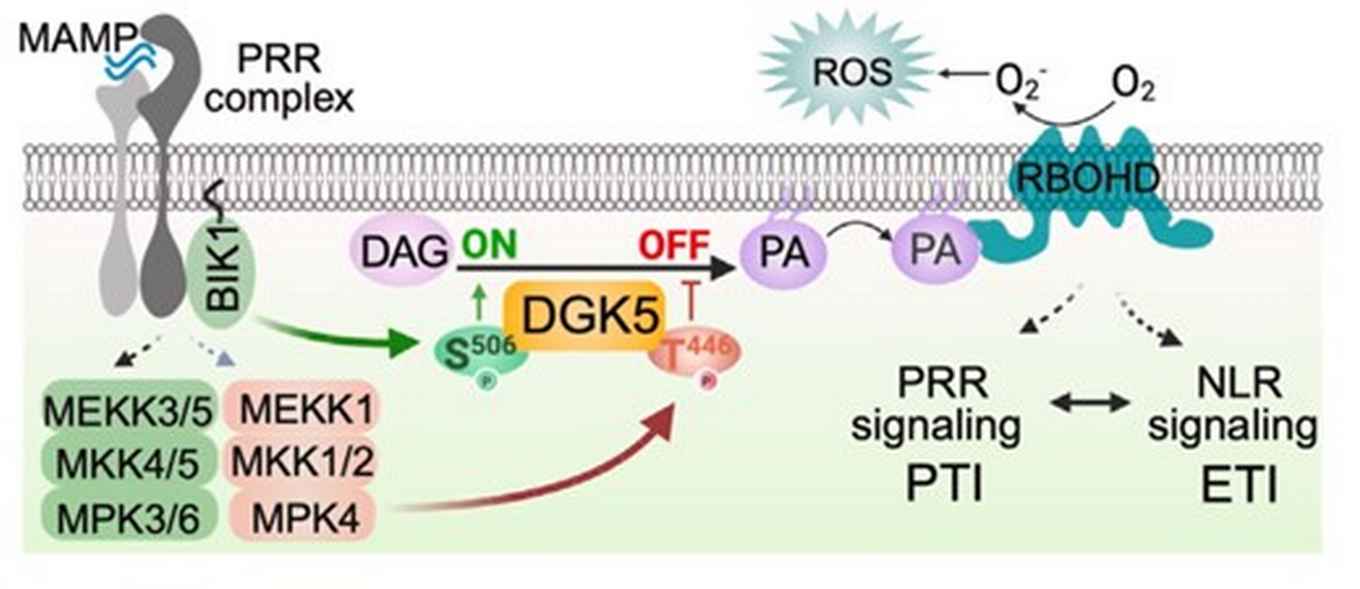New publication in Cell
Dual phosphorylation of DGK5-mediated PA burst regulates ROS in plant immunity
26 January 2024

Microbe-associated molecular patterns (MAMPs) are molecular signatures that are highly conserved in whole classes of microbes but are absent from the host, such as chitin for fungi and flagellin for bacteria. Over twenty years ago, Munnik's group (Plant Cell Biology, SILS) discovered that MAMPs, then called elicitors, triggered the formation of the lipid second messenger, phosphatidic acid (PA) in various plant systems.1-3 Recently, in collaboration with Ana Laxalt's lab (Mar del Plate, Argentina), a former post-doc of Munnik, genetic evidence was provided for the participation of phospholipase C (PLC) in this response.4 In animal systems, receptor-mediated activation of PLC produces diacylglycerol (DAG) as second messenger to activate protein kinase C and TRP channels. In plants systems, however, such targets are missing, and instead, DAG is phosphorylated into PA by a DAG kinase (DGK). Now, with a beautiful paper published in Cell5, the subtle activation mechanism of DGK is unfolded. Controlled by two distinct protein kinases, DGK5 activity is switched ON- and OFF, upon activation of the receptor kinase, FLS2 by flagellin. The membrane-localised PA, transiently activates the NADPH-Oxidase, RbohD, which produces ROS as a first layer of defense against microbes.
References
- Van der Luit AH, Piatti T, van Doorn A, Musgrave A, Felix G, Boller T, Munnik T. (2000) Elicitation of suspension-cultured tomato cells triggers formation of phosphatidic acid and diacylglycerol pyrophosphate. Plant Physiol. 123: 1507-1515.
- Den Hartog M, Verhoef N, Munnik T. (2003) Nod factor and elicitors activate different phospholipid signaling pathways in suspension-cultured alfalfa cells. Plant Physiol. 132: 311-317.
- De Jong CF, Laxalt AM, Bargmann BOR, de Wit PJGM, Joosten MHAJ, Munnik T. (2004). Phosphatidic acid accumulation is an early response in the Cf-4/Avr4 interaction. Plant J. 39: 1-12.
- D’Ambrosio JM, Couto D, Fabro G, Scuffi D, Álvarez ME, Lamattina L, Munnik T, Andersson MX, Zipfel C, Laxalt AM. (2017) PLC2 regulates MAMP-triggered immunity by modulating ROS production in Arabidopsis. Plant Phys. 175: 970-981.
- Kong L, Ma X, Zhang C, Kim S-L, Li B, Thapa H, Chen S, Yeo I-C, Devarenne TP, Munnik T, He P, Shan L. (2024). Dual phosphorylation of a diacylglycerol kinase by two distinct protein kinases regulates phosphatidic acid homeostasis in plant immunity. Cell 187: 1-15.